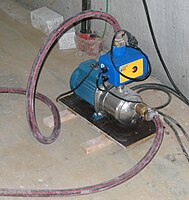
Photo from wikipedia
Abstract The use of rear cavities at the base of a square-back Ahmed body has been experimentally evaluated as a passive control device under cross-wind conditions with yaw angles β… Click to show full abstract
Abstract The use of rear cavities at the base of a square-back Ahmed body has been experimentally evaluated as a passive control device under cross-wind conditions with yaw angles β ≤ 10 ° , by means of pressure, force and velocity measurements. A comparative study has been performed at a Reynolds number R e = 10 5 , considering the reference square-back body (i.e. the body without any passive control device), and the same body implementing both straight and curved cavities as add-on devices. It is shown that the performance of a straight cavity, which is widely acknowledged as a robust drag reduction device for car models, is hindered under moderate cross-wind conditions, and does not constitute an efficient control strategy, especially when compared with a curved cavity. In particular, when the freestream is aligned with the body, the curved cavity provides a stronger attenuation of the fluctuating nature and the bi-stable dynamics of the wake (characteristic of the wake behind a square-back Ahmed body) than the straight one. Besides, the reduced size of the near wake, which is provoked by flow re-orientation and the reduced span between the rear edges of the curved cavity, leads to an important base pressure recovery, that translates into relative reductions of the drag of 9.1 % in comparison with the reference case (i.e. 2.6 % , with respect to the straight cavity). The results are considerably improved under cross-wind conditions, since the increase with the yaw angle of the force is particularly intense for the body with the straight cavity and attenuated for the model with the curved cavity. Thus, the relative reduction of the drag coefficient with respect to the reference body becomes negligible for the straight device at a yaw angle of 10°, while it still represents approximately a 10 % for the curved cavity. Furthermore, flow visualizations show that the wake is deflected as the incident flow is increasingly yawed, leading to the formation of a single leeward vortex core that approaches progressively the body, decreasing the base pressure. This phenomenon is minored when a curved cavity is implemented, increasing the low pressure induced at the body base.
Journal Title: Journal of Wind Engineering and Industrial Aerodynamics
Year Published: 2020
Link to full text (if available)
Share on Social Media: Sign Up to like & get
recommendations!